Wet Flies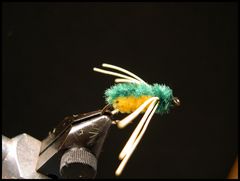 The Hum BugThe Hum Bug, developed by the Gaines Company years ago, is one of four panfish patterns in their Grubby Bug series. The other three patterns are the Grubby Gert, the Marabou Miss, and the Nifty Nat. Materials List
Tying NotesThe Green and Yellow Hum Bug is an easy chenille bodied fly to tie. The only materials required are two colors of chenille, a wet fly hook, black thread, and some rubber legs. The Gaines company bills this little guy as a slow sinker, so if you want to fish the Hum Bug the way it was intended to be fished, adding weight by wrapping the shank with lead wire is out of the question. 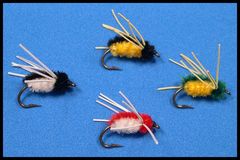 The Hum Bug comes in four different color combinations. Green and Yellow, Black and Yellow, Black and White, and Red and White -- all with white rubber legs and a black thread head. The Mustad 3906 wet fly hook is the ideal iron for the Hum Bug. The materials list calls for a size 10 hook but I also make a slightly smaller version, to use as a dropper fly, by using a size 12 hook, fine rubber legs, and small or fine chenille. You may want to check out the "Tying With Chenille" page before you tie your first Hum Bug. The page contains some great tips that will make working with chenille more fun and your chenille bodied flies more attractive. If you don't tie your own flies you can purchase original Hum Bugs and other flies in the Grubby Bug series from the Gaines Company at P.O. Box 35, Gaines, PA 16921. They have a great catalog that lists the Grubby Bug flies along with other warmwater poppers and streamers. Angling TipsFish theHum Bug in the same manner that you would fish the Panfish Polecat or the Brim Fly -- parallel to weed lines, fallen trees, and other structure. But remember, unlike the Brim Fly and the Panfish Polecat, the Hum Bug is a slow sinking fly. Cast it out and let it settle in the water slowly. Often times panfish will hit it on the fall. If you tie the Hum Bug on the smaller size 12 hook, try using it as a dropper off of a popping bug. Often times fish will hit a dropper or trailing fly instead of the lead or point fly. If you do fish the Hum Bug as a dropper, attach it to a 12 to 16 inch piece of leader material that is attached to the bend of the popper. For more information about the kind of knots used to attach a dropper or trailing fly, click on "How To Tie Knots."  Tying Steps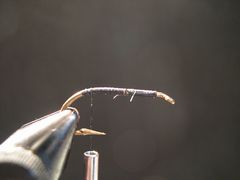 Step 1 Clamp the hook in the vice, crimp the barb, and start the thread at the hook's eye as shown. Cover the hook's shank with tight wraps of thread from the hook's eye to the hook's bend. 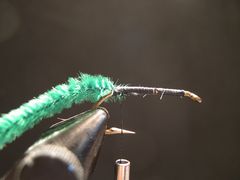 Step 2 Attach a piece of green chenille for the shellback directly on top of the hook's shank at the hook's bend. 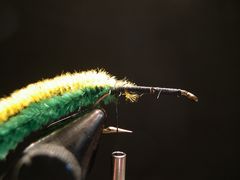 Step 3 Attach a piece of yellow chenille for the body at the same place that you attached the green chenille. 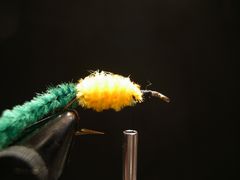 Step 4 Wrap the yellow chenille forward to the two-thirds point on the hook's shank. Tie the chenille down and remove any excess. 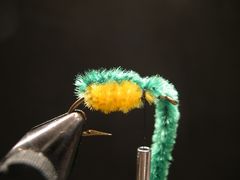 Step 5 Pull the green chenille for the shellback forward and bind it down with a couple turns of thread. 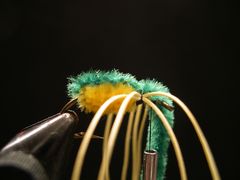 Step 6 Prepare two sets of rubber legs with two rubber strands in each set. The rubber strands should be about two-inches long. Attach one set of legs to the far side of the hook and one set to the near side. 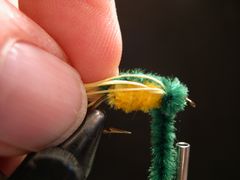 Step 7 Pull the legs back and out of the way with your left hand while you wrap a chenille head with your right hand. The first wrap of chenille should be as tight as possible against the legs. The second wrap of chenille should be on top of the first wrap followed by one additional wrap in front of the first wraps and behind the hook's eye. Bind down the chenille with a couple of tight wraps of thread and remove any excess. 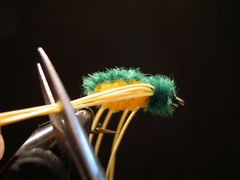 Step 8 Form a neat thread head, tie off with a couple of half-hitches or a whip finish, and clip the thread. Trim the legs to suit you. I like them to extend about a quarter of an inch beyond the fly's butt. 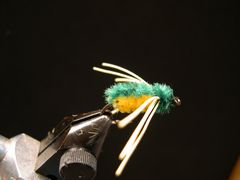 Step 9 Your Hum Bug is finished!
Warmwater Fly Tyer - by Ward Bean
© Copyright 2025 Ward Bean, Council Bluffs, IA, All rights reserved. © Copyright 2025 Ward Bean, Council Bluffs, IA, All rights reserved.
|